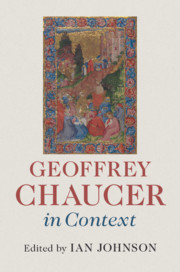Book contents
- Geoffrey Chaucer in Context
- Geoffrey Chaucer in Context
- Copyright page
- Contents
- Illustrations
- Contributors
- Abbreviations
- Introduction
- Part I Chaucer as Context
- Part II Books, Discourse and Traditions
- Chapter 3 Chaucer’s Linguistic Invention
- Chapter 4 Chaucer and London English
- Chapter 5 Manuscripts and Manuscript Culture
- Chapter 6 Chaucer’s Books
- Chapter 7 Authority
- Chapter 8 Literary Theory and Literary Roles
- Chapter 9 Metre and Versification
- Chapter 10 Dialogue
- Chapter 11 Romance
- Chapter 12 Love
- Chapter 13 Chaucer and the Classics
- Chapter 14 The French Context
- Chapter 15 The Italian Tradition
- Chapter 16 The English Context
- Chapter 17 Chaucer’s Competitors
- Chapter 18 Boethius
- Part III Humans, the World and Beyond
- Part IV Culture, Learning and Disciplines
- Part V Political and Social Contexts
- Part VI Chaucer Traditions
- Further Reading
- Index
Chapter 5 - Manuscripts and Manuscript Culture
from Part II - Books, Discourse and Traditions
Published online by Cambridge University Press: 24 June 2019
- Geoffrey Chaucer in Context
- Geoffrey Chaucer in Context
- Copyright page
- Contents
- Illustrations
- Contributors
- Abbreviations
- Introduction
- Part I Chaucer as Context
- Part II Books, Discourse and Traditions
- Chapter 3 Chaucer’s Linguistic Invention
- Chapter 4 Chaucer and London English
- Chapter 5 Manuscripts and Manuscript Culture
- Chapter 6 Chaucer’s Books
- Chapter 7 Authority
- Chapter 8 Literary Theory and Literary Roles
- Chapter 9 Metre and Versification
- Chapter 10 Dialogue
- Chapter 11 Romance
- Chapter 12 Love
- Chapter 13 Chaucer and the Classics
- Chapter 14 The French Context
- Chapter 15 The Italian Tradition
- Chapter 16 The English Context
- Chapter 17 Chaucer’s Competitors
- Chapter 18 Boethius
- Part III Humans, the World and Beyond
- Part IV Culture, Learning and Disciplines
- Part V Political and Social Contexts
- Part VI Chaucer Traditions
- Further Reading
- Index
Summary
How, and in what forms, did Chaucer’s poems reach medieval readers in the manuscript age? How was Chaucer’s writing (both process and actual content) affected by the manuscript culture within which he wrote? And for the modern reader of Chaucer, what insights are to be gained from a heightened awareness of the manuscript context from which his poetry emerged? The sheer difficulty of obtaining texts in the age of manuscript is difficult to imagine from a world with print, never mind one with instant internet access. A medieval reader keen to acquire a copy of Chaucer needed money, connections, and above all patience. A modern reader in search of Chaucer, meanwhile, needs to understand something of the vast, shifting manuscript matrix from which all modern editors have, like so many hopeful Dr Frankensteins, tried to re-create his texts. A better understanding of this manuscript culture, which robbed authors of control over their texts and could even remove their name, can also illuminate aspects of Chaucer’s process of composition, and may even help to explain his infamous use of an alter-ego narrator-figure, often explicitly named ‘Geffrey’, into his major poems.
- Type
- Chapter
- Information
- Geoffrey Chaucer in Context , pp. 43 - 49Publisher: Cambridge University PressPrint publication year: 2019

